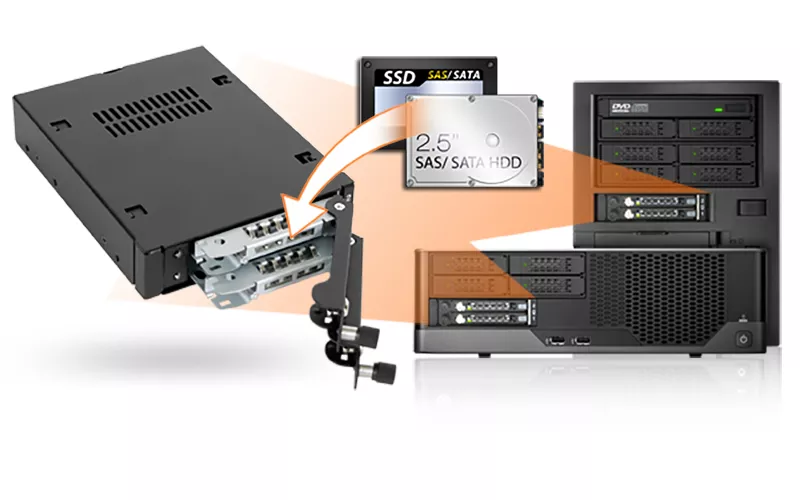
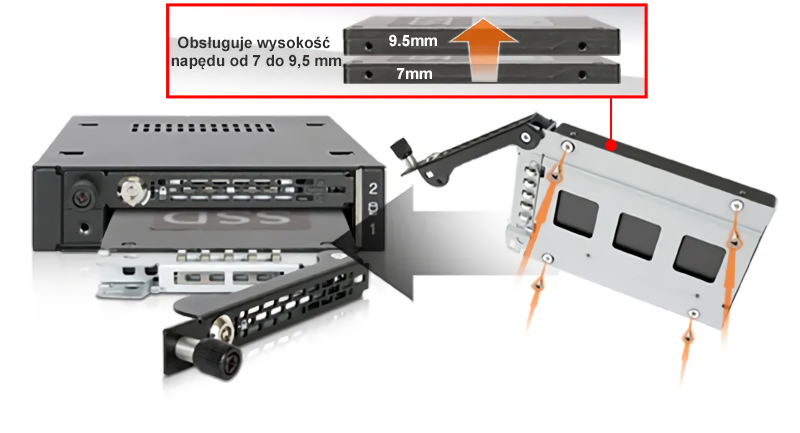
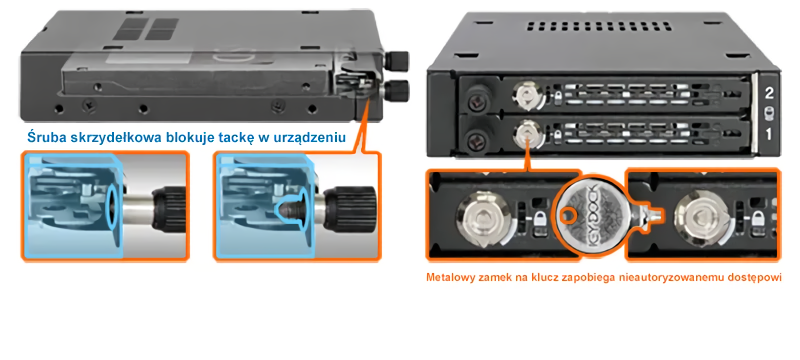
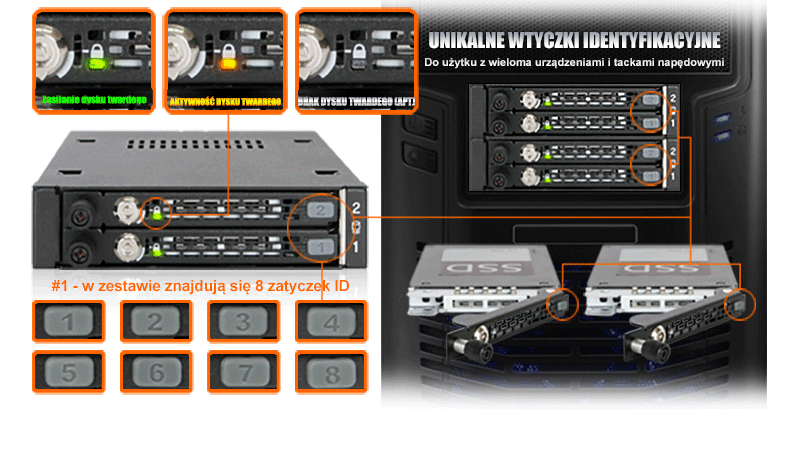
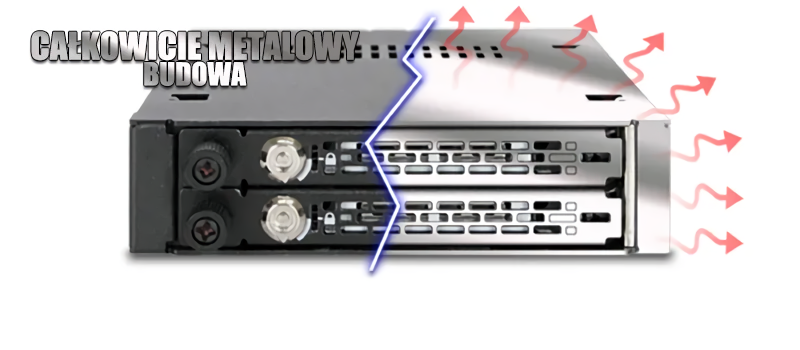
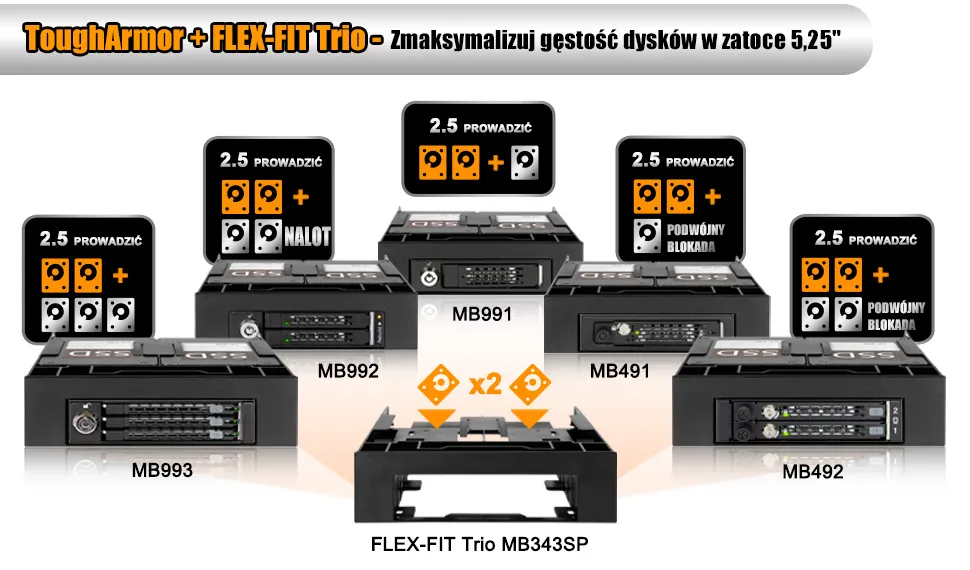
| Opcjonalne certyfikaty dostępne dla ToughArmor EX MB492SKL-B | |
| TAA | Zgodność z Trade Agreements Act |
| UL | Certyfikacja standardów bezpieczeństwa |
| UL94 | Palność materiałów z tworzyw sztucznych |
| FCC | Zgodność z przepisami Federal Communications Commission |
| Szeroki zakres temperatur | MIL-STD-810H - Method 501.7 & 502.7 |
| Test wibracji | MIL-STD-810H, Method 514.8, Procedure I (Odporność na wibracje) |
| Szok funkcjonalny | MIL-STD-810H, Method 516.8- Procedure I (Ochrona przed wstrząsami) |
| *IEC 60529 (IPX6) | Ochrona przed strumieniami wody |

| • |
Konstrukcja przeznaczona dla SFF, małe komputery przemysłowe, systemy nadzoru, systemy automatyki, systemy lotnicze i mobilne systemy DVR
|
| • |
Mieści 2 dyski w jednej 3,5” zatoce, która jest idealna do konfiguracji RAID
|
| • |
Dual Lock Design – metalowy zamek z kluczem (dla bezpieczeństwa) oraz blokada śrubowa (w przypadku uderzenia/wibracji)
|
| • |
Wyjmowana tacka napędu umożliwia łatwą konserwację i wspiera funkcję SATA hot-swap
|
| • |
Unikalne ID dla napędów (#1 - #8)
|
| • |
Mieści 2x 2,5” HDD/SSD SATA o wysokości 5-9,5 mm w jednej 3,5” zatoce
|
| • |
Obsługuje HDD/SSD SATA lub SAS z prędkością 6 Gbps i jest wstecznie kompatybilny z dyskami i hostami SAS 3 Gbps (host SAS jest wymagany dla dysków SAS)
|
| • |
Obsługuje SATA 3.0 6Gbps lub SAS 3.0 12Gbps (Single Channel)
|
| • |
W pełni metalowa konstrukcja idealna dla przedsiębiorstw
|
| • |
Technologia Multi-Flow zapewnia doskonałe chłodzenie pasywne
|
| • |
Anti-Vibration Technology tworzy bezpieczne środowisko dla dysków HDD/SSD
|
| • |
Active Power Technology zasila LED tylko wtedy, gdy dysk jest umieszczony wewnątrz
|
| • |
Uziemienie EMI chroni dyski przed szkodami elektrycznymi
|
| • |
Klips dla złącza SATA – zarówno 7- jak i 15-pinowego
|
| • |
Zgodność z MIL-STD-810H metoda 516.8 (wstrząsy) i 514.8 (wibracje)
|
| Model Number: | MB492SKL-B |
| Color: | Black |
| Support Drive Size: | 2.5" SATA HDD/SSD |
| Compatible Drive Type: | SATA / single channel SAS (SAS host required) |
| Number of Drives: | 2 |
| Max Drive Height: | 9.5mm |
| Drive Bay: | 1 x 3.5" drive bay |
| Host Interface: | 2 x 7pin SATA |
| Power Input: | 1 x SATA 15pin power |
| Transfer Rate: | SATA 3.0 up to 6Gbps / SAS 3.0 up to 12Gbps (single channel) |
| Support HDD Capacity: | No limitation |
| Drive Cooling: | Metal heat dispersion |
| Structure / Material: | Full metal |
| Support Hot-Swap: | Yes |
| Drive Security: | Thumb screw lock & 2-segment keylock |
| Product Dimension (L x W x H): | 138 x 101.2 x 25.4 mm |
| Product Net Weight: | 413g |
| Package Gross Weight: | 470g |
| Drive Activity LED Indication: | Drive power: solid green; HDD access: flashing amber |
| Package Contents: | Device, user manual, screws, keys, drive ID plug |
| SATA Connector Insertion Rate: | 10,000 |
| Humidity: | 5%~65% RH |
| Operating Temperature: | 0°C to 60°C (32°F to 140°F) |
| Storage Temperature: | -35°C to 70°C (-31°F to 158°F) |
| Compliance: | CE, RoHS, REACH |
| Warranty: | 5 years limited warranty |
Compatible Drive Tray (Caddy):
Related Products:
Related Products Series:
Quick Link:
Q: Does MB492SKL-B support the new SATA 3.3 / SAS 3.0 Power Disable feature (PWDIS)?
A: The MB492SKL-B does not support the SATA 3.3 / SAS 3.0 PWDIS feature. If you install the SATA/SAS HDD/SSD with PWDIS in MB492SKL-B , the drive will not spin, and the system won't detect the drive. See the list below for known SATA/SAS HDD/SSD with the PWDIS feature.
While we recommend to avoid using the SATA/SAS HDD/SSD with PWDIS, you can use the methods below to disable the PWDIS feature physically if you already purchased the drive:
Method 1 – Using the Molex to SATA adapter or cable to disconnect the power to Pin 3 of the SATA power connector.
 |
 |
|
| Molex to SATA Adapter | Molex to SATA Cable |
Method 2 – Placing Kapton tape on Pin 1-3 of the SATA/SAS power connector to isolate the 3.3V power, as shown below.
 |
 |
Please contact tech@icydock.com if the problem persists.

3.5” Mobile Racks for 2.5" SATA/SAS SSD/HDD
With ICY DOCK’s 3.5” drive bay enclosure series, we can maximize the unused 3.5" drive bay of any workstation with an easily removable drive enclosure in the frontal bay. We believe this is critical for most industries that are transitioning to be more efficient, frequently require more drive swap than others, and the ability to transport data from one system to another when drives are in the frontal bay as opposed to being stored internally.
